Research article
A. Soltani,1 H. Vatandoost,1 H. Jabbari,2,3 A.R. Mesdaghinia,1,2 A.H. Mahvi,1,2 M. Younesian,1,2 A.A. Hanafi-Bojd 1 and S. Bozorgzadeh 4
النَّجَاعة الميدانية لمكافحة البعوض بخَرَزات البولي ستيرين الموسعة وشرائد فضلات خَرَزات البولي ستيرين في برك صناعية وتجارب ميدانية في جمهورية إيران الإسلامية
ابو ذر سلطاني، حسن وطن دوست، حسين جبارى، عليرضا مصداقي نيا، أمير حسين محوي، مسعود یونسیان، أحمد علي حنفي بجد، سعيد بزركَزاده
الخلاصة: أدت مشاعر القلق من مبيدات الهوام الكيميائية التقليدية إلى زيادة البحوث من أجل الوصول إلى طرق مكافحة مبتكرة للبعوض. وتقارن هذه الدراسة فعالية نوعين مختلفين من خرزات البولي ستيرين في مكافحة يرقات البعوض في جنوب شرق جمهورية إيران الإسلامية. وقد أجريت تجارب محاكاة ميدانية في برك صناعية وتجارب ميدانية في قريتين في منطقة مأهولة بالملاريا، باستخدام الطرق الموصى بها من منظمة الصحة العالمية. وقد أدى تطبيق الخرزات الموسعة للبولي ستيرين أو شرائد فضلات رقائق البولي ستيرين على أسطح البرك إلى اختلاف يعتد به في كثافة البعوض قبل المعالجة وبعدها (حدث خفض بمقدار %86 و %78 بعد أسبوعين من المعالجة). ولم يوجد فرق يعتد به في النجاعة بين النوعين. وعلى هذا فإن استخدام خرزات البولي ستيرين كمكون ضمن التدبير المتكامل للنواقل مع سائر التدابير الأخرى، يمكن أن يساعد في مكافحة الأمراض المنقولة بالبعوض في جمهورية إيران الإسلامية والبلدان المجاورة لها.
ABSTRACT Concerns about traditional chemical pesticides has led to increasing research into novel mosquito control methods. This study compared the effectiveness of 2 different types of polystyrene beads for control of mosquito larvae in south-east Islamic Republic of Iran. Simulated field trials were done in artificial pools and field trials were carried out in 2 villages in an indigenous malaria area using WHO-recommended methods. Application of expanded polystyrene beads or shredded, waste polystyrene chips to pool surfaces produced a significant difference between pre-treatment and post-treatment density of mosquitoes (86% and 78% reduction respectively 2 weeks after treatment). There was no significant difference between the efficacy of the 2 types of material. The use of polystyrene beads as a component of integrated vector management with other supportive measures could assist in the control of mosquito-borne diseases in the Islamic Republic of Iran and neighbouring countries.
Efficacité sur le terrain des billes de polystyrène expansé et de copeaux de polystyrène recyclé pour la lutte contre les moustiques dans des bassins artificiels et des essais sur le terrain en République islamique d'Iran
RÉSUMÉ Les préoccupations concernant les pesticides chimiques traditionnels ont conduit à intensifier la recherche sur de nouvelles méthodes de lutte contre les moustiques. La présente étude a comparé l'efficacité de deux types de billes de polystyrène dans la lutte antilarvaire dans le sud-est de la République islamique d'Iran. Les simulations d'essais sur le terrain ont été réalisées dans des bassins artificiels alors que les essais sur le terrain ont été menés dans deux villages d'une zone où le paludisme est autochtone, avec des méthodes recommandées par l'Organisation mondiale de la Santé. L'application de billes de polystyrène expansé ou de copeaux de polystyrène recyclé sur la surface des bassins a entraîné une différence significative entre la densité des moustiques avant et après le traitement (86% et 78% de réduction respectivement après deux semaines de traitement). Il n’y avait pas de différence significative entre l'efficacité des deux types de matériaux. L'utilisation de billes de polystyrène en tant que composante de la gestion intégrée des vecteurs avec d'autres mesures d'appui pourrait contribuer à la lutte contre les maladies transmises par des moustiques en République islamique d'Iran et dans les pays voisins.
1School of Public Health and Institute of Health Research; 2Centre for Environmental Research; 3Digestive Diseases Research Centre, Tehran University of Medical Sciences, Tehran, Islamic Republic of Iran (Correspondence to H. Vatandoost:
4Chabahar Free-Trade Zone Organization, Chabahar, Sistan and Baluchistan Province, Islamic Republic of Iran.
Received: 28/02/10; accepted: 26/05/10
EMHJ, 2012, 18(10): 1034-1041
Introduction
Growing concerns about the potential health and environmental risks surrounding traditional chemical pesticides [1,2] have led environmental protection agencies to ban or place severe restrictions on the use of many pesticides that were formerly used in mosquito control programmes. There are now fewer adulticides available than there have been for the last 20 years [3]. It is likely, therefore, that mosquitoes will quickly develop high levels of resistance to the remaining available adulticides. This has led to concern among operational mosquito control personnel that effective insecticides may not be available in the near future [4]. Hence, it is imperative that novel mosquito control methods are developed and put into general use as soon as possible.
One potential alternative bioenvironmental control measure in these habitats is the use of expanded polystyrene (EPS) beads. Besides hindering the respiration of larvae, thick layers of polystyrene beads prevent the emergence of adult mosquitoes and the layers present a dry surface unsuitable for egg laying [5,6]. These beads are nonpolluting and socially acceptable and their long-lasting, non-hazardous nature and one-time application renders it a cost-effective and feasible solution to mosquito control [1,6,7]. Shredded, waste polystyrene (SWAP) chips are another cheap and readily available product with similar properties.
According to previous studies in the Islamic Republic of Iran there are several genera of mosquitoes, including Anopheles spp., Aedes spp., Culex spp. and others, which normally share the same breeding places [8]. In some southern regions of the country, due to the lack of a piped water supply most villagers use stored water for drinking and washing. These habitats provide ideal conditions for mosquito breeding. Various re-emerged malaria epidemics have occurred in Iranian cities in the recent years. A number of methods for mosquito control in the country have been reported, including source reduction, biocontrol (Bacillus thuringiensis and larvivorous fishes), larviciding and adulticiding [9–12].
The objective of the present study was to evaluate the efficacy of locally made industrial polystyrene products for mosquito control under simulated field and actual field trial conditions in Sistan and Baluchestan province, Islamic Republic of Iran. The expected outcome was to determine a safe, cheap, feasible, applicable and environmental friendly measure for mosquito larvae control.
Methods
Simulated field trials
Application of polystyrene beads was tested for their efficacy in controlling mosquito larvae and pupae of Anopheles spp. and Culex spp. under simulated field conditions in 2 phases during different seasons: December 2006 and June 2007.
The study was carried out in artificial pools at Bandar Abbas health research centre. Two months prior to the tests 6 artificial pools (5 m3: dimensions 1 × 1 × 0.5 m) were excavated and the base of the pools was covered with 2 thick layers of waterproof plastic. The artificial pools were filled with well-water in order to prepare breeding places for mosquitoes under natural conditions. Water levels in the artificial pools were monitored and maintained at 0.4 m depth by carefully adding fresh water periodically during the trials. Three artificial pools were selected for the larval density tests and remained uncovered. Three artificial pools were selected for the adult emergence test and covered with emergence traps (1 m³ made of net with 156 holes/inch2) to record the daily number of adults emerging. For each set of tests, 1 pool was treated with EPS beads, 1 pool treated with SWAP chips and 1 control pool was left untreated.
Before adding the polystyrene beads to the water surface, we calculated the daily density of larvae (density per 10 dippers) and adult emergence (by mouth aspirator) over 3 days. Then on the 3rd day polystyrene beads were added to the pools, and the densities of larvae and adults emerging were calculated and recorded daily for up to 2 weeks. Supplies of EPS and SWAP were purchased from a local Iranian factory. EPS beads (2 mm diameter) were applied in a 1 cm thick floating layer and SWAP was applied in a 1–2 cm floating layer. Air temperature and relative humidity were recorded daily. At the end of the experiments, water samples from the pools were analysed by gas chromatography for the levels of dissolved monostyrenes.
Field trials under natural conditions
Field evaluations of polystyrene beads were carried out in 2 villages near Chabahar (Comb and Tis) where malaria is indigenous. The villages are located in Sistan and Baluchestan province in the south-east of the Islamic Republic of Iran (25°17ʹN, 60°38ʹE). The trials were carried out from September to November 2007.
Breeding sites were selected for the field trials based on high larval populations and evidence of continued oviposition. Among the various types of mosquito breeding habitats that were available in the study area, 9 cement water reservoirs, of over or underground construction, were selected for the present study. Before the polystyrene application, information on the mosquito species in the breeding sites was obtained by collecting samples of immature adults after emergence from all pools. These were kept separately in the laboratory according to habitat for species identification. Information about the general topography of the area, weather conditions, water temperature, and pH of water also was recorded.
The pre-treatment density of mosquito larvae was calculated in all pools for 3 days. On the 3rd day EPS beads and SWAP chips were added to the water surface of treated pools, based on a Latin square design (Figure 1). The efficacy of the 2 types of polystyrene against larval and pupal density was evaluated and compared with control pools for 2 weeks after treatment and then after 1 month. Larval density was measured using a standard dipper consisting of a white aluminium bowl (diameter 9 cm, 300 mL capacity) [13]. A fixed number of 10 dippers were taken in the periphery and the centre of the pools. Larvae and pupae collected by dipping were pooled by site in white trays, counted and released back into the respective habitats. Samples of late-stage larvae and pupae were collected and brought to the laboratory for species identification after mounting. Pre-treatment and post-treatment densities of immature mosquitoes (Ι + ΙΙ instars, ΙΙΙ + ΙV instars, and pupae) per 10 dippers were recorded separately for both treatment and control sites. The efficacy and durability of effectiveness of the 2 type of polystyrene were determined from the post-treatment counts of larvae and pupae in treated and control sites as compared to the pre-treatment populations.
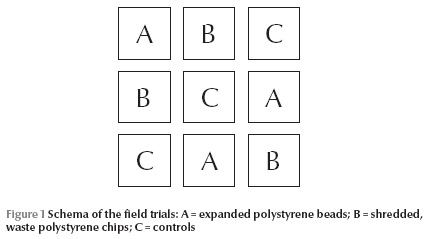
Statistical analysis
Percentage reduction was calculated using the formula [13]: % reduction = 100–(C1 × T2 / T1 × C2) × 100.
Where C1 and T1 are the pre-treatment immature densities in the control and treated habitat and C2 and T2 are the post-treatment immature densities in control and treated habitat. Means were compared using statistical tests of non-parametric (Mann–Whitney U-test) using SPSS, version 11.5 software. P < 0.05 indicated significant difference between treatments.
Results
Simulated field trials
The results of species identification of larvae and adult mosquitoes collected in artificial pools in 2 different seasons of 2007 are showed in Figure 2. This shows that in December Culex spp. mosquitoes were the dominant species, whereas in June, Anopheles spp. were dominant.
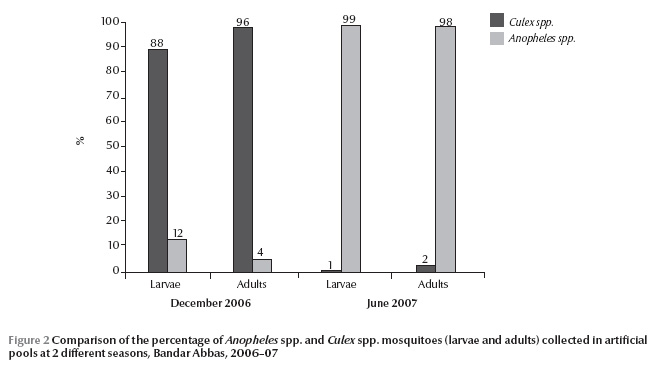
Trends of larval densities and adults emerging in EPS- and SWAP-treated and untreated artificial pools in the 2 different seasons are shown in Figure 3 . Analysing the data for the 2 seasons combined showed no significant difference in the pre- and post-treatment periods in the number of mosquitoes in control artificial pools, either larvae (P = 0.410) or adults (P = 0.376). However, significant differences were clearly observed in the numbers of mosquitoes (adults and larvae) in the 2 treated artificial pools pre- and post-treatment, both for larva (P = 0.041 and P = 0.007 for EPS and SWAP respectively) and for adult stages (P = 0.001 and P = 0.012 for EPS and SWAP respectively).
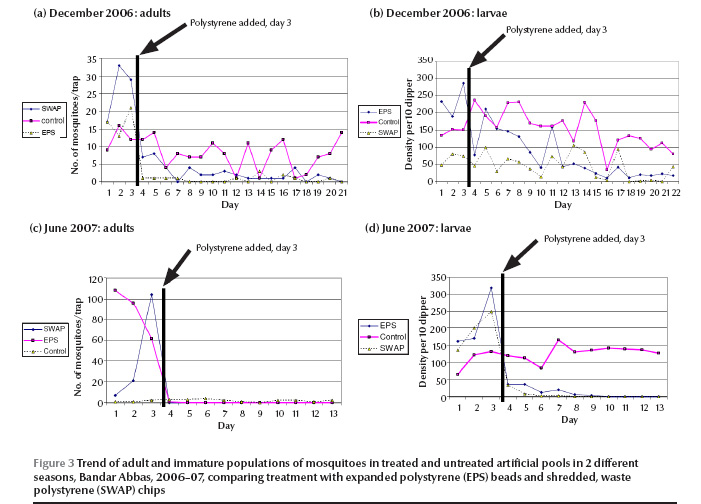
The levels of dissolved monostyrene are shown in Figure 4. This shows that the rate of detected monostyrene at all pools was considerably less than the Environmental Protection Agency’s standard of polystyrene level for potable water (0.32 ppm) [14].
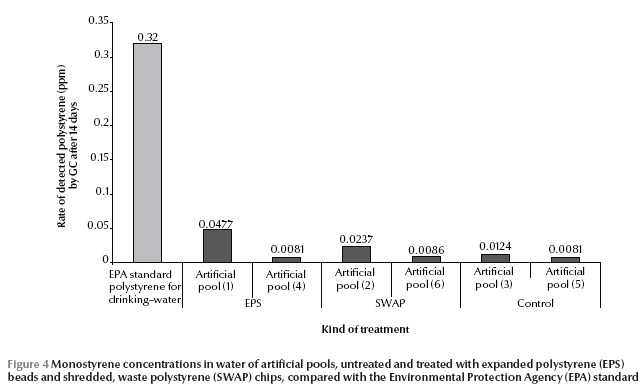
The prevalence of identified mosquitoes showed that An. stephensi and Cx. pipiens were the dominant species in Bandar Abbas (data not shown).
Field trials
The larval densities pre- and post-treatment in treated and control pools are showed in Figure 5. The results showed no significant difference comparing the pre-treatment and post-treatment density in control pools (P = 0.621), whereas a significant difference was observed between pre-treatment and post-treatment density in both kinds of treatment pools (P = 0.001 and P = 0.002 for EPS and SWAP respectively). There was no significant difference in larval densities between EPS- and SWAP-treated pools (P = 0.15).
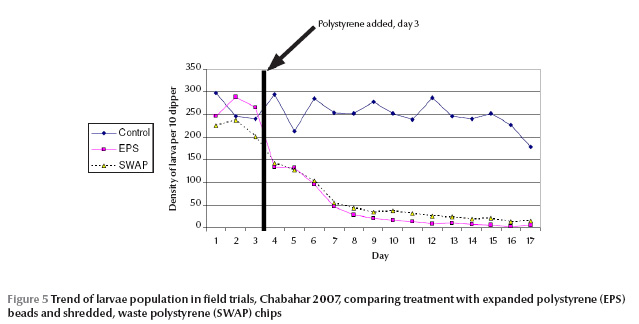
In EPS-treated pools, a more than 86% reduction was observed in immature mosquito densities comparing the pre-treatment period with the 2 weeks post-treatment (P < 0.001). The figure for SWAP-treated pools was a 78% reduction over the same period (P < 0.001) (Figure 6).
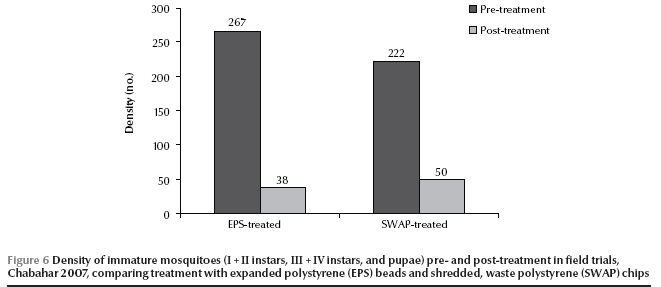
The results of identified mosquito based on species composition showed the dominance of the vector species An. stephensi in this area (82%); considerably higher than An. culicifacies (9%), An. dthali (4%), An. turkhudi (2%), An. superpictus (2%) and An. sergentii (1%).
Discussion
There are several reports from other parts of the world concerning the use of polystyrene beads for elimination of mosquito emergence in cesspits, flooded cellars, soakage pits, water tanks, gem pits and industrial complexes [5,15–26]. We have previously evaluated the efficacy of locally made industrial beads under laboratory conditions [27]. The polystyrene layer reduces the density of mosquitoes by suffocating larvae and pupae and inhibiting mosquito egg-laying in water bodies. Our results also showed that EPS beads and SWAP chips are effective and practical methods for reduction of An. stephensi, Cx. pipiens and other mosquitoes, under simulated field and actual field trial conditions. Larval mortality increased significantly using both types of polystyrene.
We observed an 86% and 78% reduction rate of immature mosquito densities for EPS- and SWAP-treated pools respectively in actual field trial situations. A range of surface treatments for mosquito control including polystyrene beads have been tested in other studies. Similar studies with EPS in Zimbabwe, India and Zanzibar showed a mortality rate of 72.3%–100% [6,7]. Reduction of emergence of Ae. triseriatus was found using scrap EPS beads in the laboratory and in field trials in tree holes [28]. The superiority of polystyrene beads over oil application to water surfaces on the control of mosquito breeding was found in cesspits in Egypt [29]. Reduction of Cx. quinquefasciatus and Ae. Albopictus densities using EPS beads in septic tanks was demonstrated in Tanzania [30]. A laboratory and field trial in the Caribbean using SWAP was not able to gain 100% efficacy against emergence of adult mosquitoes in the laboratory. The authors concluded that the irregular shapes of the SWAP chips reduced their capacity to spread over the water surface and the interstitial air spaces also permitted respiration and development of mosquito larvae. However, in field trials in pit latrines with careful application of SWAP the mean number of Cx. quinquefasciatus mosquitoes declined from 487 on day 1 to only 1 on day 63 and the control was sustained for 2 months [31]. The efficacy of Agnique® MMF, a monomolecular film formulation, was tested against immature forms of An. stephensi in India. Simulated field trials carried out in cement tanks showed 100% inhibition of adult emergence for up to 3 weeks. In tanks and wells it produced a 75% reduction of late instars and 100% reduction of pupae on day 1 [32].
In the present study the figures for mortality and inhibition of emergence with the SWAP material were lower than that of EPS beads, which may be due to variability in bead diameter and irregular shapes which are not able to cover the water surface completely. Nevertheless, both materials had high larval control efficacy and there was in fact no significant difference between their efficacies in field trails, which suggest that both of them could be used in the control of mosquitoes. Analysis of our data for mosquito densities showed significant differences between pre-treatment and post-treatment density for both kinds of treatment. Levels of dissolved monostyrenes were well within the Environmental Protection Agency standard. EPS beads are therefore a promising vector control strategy to minimize the mosquito breeding sources in integrated vector management programmes, while SWAP appears to offer good prospects as an alternative to EPS for inexpensive, long-term mosquito control in selected habitats.
To be cost-effective appropriate vector control tools need to be directed in the right place and at the right time. Such methods should not be simply prescribed; instead site-specific control methods should be developed and implemented with a partnership approach. Application of polystyrene beads requires effective coverage. Polystyrene beads should be applied according to the nature of the habitats and can be applied in regions where water sources are restricted and water supply systems are non-piped, such as in the endemic malarious areas of Islamic Republic of Iran.
We conclude that the use of EPS beads and SWAP chips as a component of integrated vector management, together with other supportive measures, could assist in the elimination of mosquito-borne diseases in the Islamic Republic of Iran and neighbouring countries.
Acknowledgements
The authors are grateful to the staff of Bandar Abbas health research centre for their close collaboration during the study. This project was financially supported by the Centre for Environmental Research, Tehran University of Medical Sciences.
References
- Poopathi S, Tyagi BK. The challenge of mosquito control strategies: from primordial to molecular approaches. Biotechnology and Molecular Biology Review, 2006, 1:51–65.
- Collins LE, Blackwell A. The biology of Toxorhynchites mosquitoes and their potential as biocontrol agents. Biocontrol News and Information, 2000, 21:105–116.
- Rathburn CB. Adulticides in the ‘90s: the changing picture. Wing Beats, 1990, 1:12–13.
- Kline DL. Introduction to symposium on attractants for mosquito surveillance and control. Journal of the American Mosquito Control Association, 1994, 10:253–257.
- Reiter P. Expanded polystyrene beads: an idea for mosquito control. Annals of Tropical Medicine and Parasitology, 1978, 72:595–596.
- Sivagnaname N, Dominic Amalraj D, Mariappan T. Utility of expanded polystyrene (EPS) beads in the control of vector-borne diseases. Indian Journal of Medical Research, 2005, 122:291–296.
- Curtis CF et al. Insect proofing of sanitation system. In: Curtis CF, ed. Appropriate technology in vector control. Florida, CRC Press, 1989:173–186.
- Azari-Hamidian S. Checklist of Iranian mosquitoes (Diptera: Culicidae). Journal of Vector Ecology, 2007, 32:235–242.
- Vatandoost H, Moin Vaziri VM. Larvicidal activity of a neem tree extract (Neemarin) against mosquito larvae in the Islamic Republic of Iran. Eastern Mediterranean Health Journal, 2004, 10:573–581.
- Vatandoost H et al. Larval habitats of main malaria vectors in Hormozgan province and their susceptibility to different larvicides. Southeast Asian Journal of Tropical Medicine and Public Health, 2004, 35:22–25.
- Vatandoost H et al. Bionomics of Anopheles stephensi Liston in the malarious area of Hormozgan province, southern Iran, 2002. Acta Tropica, 2006, 97:196–203.
- Hanafi-Bojd AA, Vatandoost H, Jafari R. Susceptibility status of Anopheles dthali and An. fluviatilis to commonly used larvicides in an endemic focus of malaria, southern Iran. Journal of Vector Borne Diseases, 2006, 43:34–38.
- Guidelines for laboratory and field testing of mosquito larvicides 2005. Geneva, World Health Organization, 2005 (WHO/CDS/WHOPES/GCDPP).
- National primary drinking water regulations. United States Environmental Protection Agency [website] (http://water.epa.gov/drink/contaminants/index.cfm#List, accessed 10 September 2012).
- Curtis CF, Minjis J. Expanded polystyrene bead for mosquito control. Parasitology Today, 1985, 1:36.
- Reiter P. A field trial of expanded polystyrene balls for the control of Culex mosquitoes breeding in pit latrines. Journal of the American Mosquito Control Association, 1985, 4:519–521.
- Sharma RC, Yadav RS, Sharma VP. Field trials on the application of expanded polystyrene (EPS) beads in mosquito control. Indian Journal of Malariology, 1985, 22:107–109.
- Chandrahas RK, Sharma VP. Small-scale field trials with polystyrene beads for the control of mosquito breeding. Indian Journal of Malariology, 1987, 24:175–180.
- Dua VK, Sharma SK, Sharma VP. Use of expanded polystyrene beads for the control of mosquitoes in an industrial complex at Hardwar, India. Journal of the American Mosquito Control Association, 1989, 5:614–615.
- Maxwell CA et al. Control of Bankroftian filariasis by integrating therapy with vector control using polystyrene beads in wet pit latrines. Transactions of the Royal Society of Tropical Medicine and Hygiene, 1990, 84:709–714.
- Chandrahas RK et al. Involvement of voluntary agencies in malaria control in Madras city. In: Sharma VP, ed. Community participation in malaria control. Delhi, Malaria Research Centre, 1993:211–229.
- Curtis CF. Approaches to vector control: new and trusted. 4. Appropriate technology for vector control: impregnated bed nets, polystyrene beads and fly traps. Transactions of the Royal Society of Tropical Medicine and Hygiene, 1994, 88:144–146.
- Chavasse DC et al. Mosquito control in Dar el Salaam. II. Impact of expanded polystyrene beads and pyriproxyfen treatment of breeding sites on Culex quinquefasciatus densities. Medical and Veterinary Entomology, 1995, 9:147–154.
- Reuben R et al. Annual single-dose diethylcarbamazine plus ivermectin for control of filariasis: comparative with and without vector control. Annals of Tropical Medicine and Parasitology, 2001, 95:361–378.
- Yapabandara AMGM, Curtis CF. Laboratory and field comparisons of pyriproxyfen, polystyrene beads and other larvicidal methods against malaria vectors in Sri Lanka. Acta Tropica, 2002, 81:211–223.
- Curtis CF et al. Use of floating layers of polystyrene beads to control populations of the filarial vector Culex quinquefasciatus. Annals of Tropical Medicine and Parasitology, 2002, 96:97–104.
- Soltani A et al. Use of expanded polystyrene (EPS) and shredded waste polystyrene (SWAP) beads for control of mosquitoes. Iranian Journal of Arthropod-Borne Diseases, 2008, 2(2):12–20.
- Beehler JW, DeFoliart GR. Potential use of scrap expanded polystyrene beads for the control of Aedes triseriatus. Journal of the American Mosquito Control Association, 1991, 7:299–300.
- Bekheit SS et al. Small scale field trial with polystyrene beads for the control of mosquito breeding. Journal of the Egyptian Society of Parasitology, 1991, 21:179–182.
- Chang MS, Lian S, Jute N. A small scale field trial with expanded polystyrene beads for mosquito control in septic tanks. Transactions of the Royal Society of Tropical Medicine and Hygiene, 1995, 89:140–141.
- Nathan MB et al. Control of Culex quinquefasciatus in pit latrines, using shredded waste polystyrene. Annals of Tropical Medicine and Parasitology, 1996, 90:207–212.
- Batra CP et al. Eficacy of Agnique MMF monomolecular surface film against Anopheles stephensi breeding in urban habitats in India. Journal of the American Mosquito Control Association, 2006, 22:426–432.








